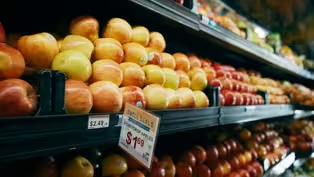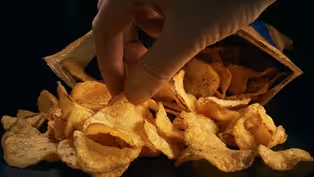
The True Cost of Shrimp: What the Grocery Store Doesn’t Show You
Clip: Season 2 Episode 1 | 13m 11sVideo has Closed Captions
Shane uncovers the hidden labor behind shrimp — and the global systems that keep us in the dark.
Shane Campbell-Staton investigates how shrimp became America’s #1 seafood — and reveals the exploitation and forced labor that fuel its global supply chain. With journalist Ben Lorr and activist Patima Tungpuchayakul, he exposes how modern slavery hides behind low prices and how grocery stores disconnect us from the people who feed us.
Problems playing video? | Closed Captioning Feedback
Problems playing video? | Closed Captioning Feedback

The True Cost of Shrimp: What the Grocery Store Doesn’t Show You
Clip: Season 2 Episode 1 | 13m 11sVideo has Closed Captions
Shane Campbell-Staton investigates how shrimp became America’s #1 seafood — and reveals the exploitation and forced labor that fuel its global supply chain. With journalist Ben Lorr and activist Patima Tungpuchayakul, he exposes how modern slavery hides behind low prices and how grocery stores disconnect us from the people who feed us.
Problems playing video? | Closed Captioning Feedback
How to Watch Human Footprint
Human Footprint is available to stream on pbs.org and the free PBS App, available on iPhone, Apple TV, Android TV, Android smartphones, Amazon Fire TV, Amazon Fire Tablet, Roku, Samsung Smart TV, and Vizio.
Buy Now

Surprising Moments from Human Footprint
Do you think you know what it means to be human? In Human Footprint, Biologist Shane Campbell-Staton asks us all to think again. As he discovers, the story of our impact on the world around us is more complicated — and much more surprising — than you might realize.Providing Support for PBS.org
Learn Moreabout PBS online sponsorship(mellow music) ♪ The journey for one product that we’ve come to love, and expect, starts here.
(energetic music) (female announcer) For those who have (indistinct), bring them to the level (indistinct).
♪ (Shane) You might know Thailand for its delicious cuisine, but even if you don’t love pad kee mao, you’ve probably tasted this country’s bounty.
(phone rings) -Hello.
-Hey, Ben, it’s Shane.
How’s it going?
Shane, how you doing?
(Shane) Remember Ben Lorr, the Secret Life of Groceries guy?
He’s written a lot about shrimp and its fascinating road to seafood superstardom... (video game sound effects) ...courtesy of the grocery store.
How popular is shrimp in the U.S.?
(Ben) Oh, it’s our-- it’s our number one.
(energetic music) Forget the salmon, tuna.
♪ Shrimp is America’s seafood, and we put it in everything.
♪ (Shane) Which is interesting to me because I feel like shrimp used to be a luxury item.
(elegant music) (Ben) Yeah, the silver platter with cocktail shrimp.
It was like the cuisine of the elite because it cost more than steak.
♪ (Shane) Before the 1970s, most shrimp were wild-caught, and the shrimp industry got a reputation for ravaging marine ecosystems.
(Ben) That all shifted in the ’70s to ’90s, really, this big, long evolution in aquaculture.
(Shane) In other words, shrimp farming.
These farms started small, but they didn’t stay that way for long.
(grim music) By the 1990s, Thailand was the world’s top producer of farmed shrimp.
♪ (Ben) Let’s make the pools bigger, let’s line it with plastic.
You know, like, the classic, like, "Let’s ramp it up."
♪ But there was this big problem.
When you did that, you stressed the shrimp out, and the female shrimp refused to breed.
(water flowing) (Shane) Aquaculture might have stalled out if not for a genuinely bizarre observation that cutting off shrimps’ eyes triggered an unexpected hormonal response, sending the shrimp into a kind of reproductive overdrive.
(energetic music) ♪ As production soared, prices fell and demand exploded.
But solving one problem led to another.
(Ben) Whenever you keep animals in a confined environment, you create this perfect recipe for disease.
(soft music) So, all those shrimp that you are packing in there, they’re stewing in their own feces, and that water gets toxic nasty.
(Shane) Before long, Thailand and other shrimp-farming countries were covered in contaminated pools.
(Ben) You’ve probably seen these blue-green lagoons everywhere.
-Yeah.
-Those are the ghosts of shrimp farms past.
♪ (Shane) And those ghosts can leach toxins for years afterwards.
But despite the environmental costs, our demand for shrimp kept growing.
(grim music) Thing is, shrimp have to eat too.
(Ben) At the bottom of the aquaculture pyramid is the food that shrimp eat.
Shrimp are fundamentally carnivorous.
It takes two pounds of wild-caught fish to raise one pound of shrimp.
(energetic music) (Shane) Suddenly, there was an insatiable market for what the industry calls "trash fish," marine species that people won’t eat.
The fishing industry, once focused only on edible seafood, began pulling everything they could out of the ocean.
♪ (Ben) When a fishing vessel goes out in the Andaman Sea or in Thailand to collect fish, they use something called a benthic trawl.
♪ It just rakes the bottom of the ocean floor, destroys coral and uplifts rocks.
It rips apart that environment.
(Shane) This indiscriminate fishing devastated fisheries close to shore and pushed the fleet further out to sea.
And with demand for cheap shrimp surging, the industry discovered a new way to cut costs.
♪ (mellow music) (Shane) Meet Patima Tungpuchayakul.
She finds peace perfecting traditional Thai dishes.
(Nyck Caution) ♪ I got my stripes earned, battle tested ♪ (Shane) But her true calling is helping people, no matter the risk.
-♪ Check ♪ -In the process, she and her group, the Labor Protection Network, have made enemies of some powerful institutions.
So much so that we had to meet in secret.
(somber music) Facing a shortage of local workers willing to spend months at sea, the fleets turned to cheaper and more vulnerable sources of labor.
So, people are being actively recruited and brought in, and then, once they’re there, it’s a completely different situation than they expected.
(camera shutter bursts) As a Black American, the word slaves brings up a lot of feelings for me.
(camera shutter clicking) But it’s hard to think of another word to describe this reality.
People tricked into a brutal life, where they’re bought and sold to work long, unpaid hours... ♪ ...under constant threat of violence or death.
(indistinct shouting) ♪ Many of these migrant workers have nowhere to go, even if they could escape.
(insects chirring) (Shane) In 2014, Patima and a team of journalists tracked ships, found men held in cages, and discovered remote Indonesian islands used as prisons for fishing industry slaves.
Together, they rescued nearly 2,000 people, earning Patima a nomination for the Nobel Peace Prize.
♪ Some of the men Patima helped were willing to share their stories.
Fearing for his life, this man jumped off the boat.
(water splashes) But his captors caught him and tied him to the deck for seven days.
He was tied for so long that his arm had to be amputated.
♪ (camera shutter clicking) Against his will, this man was put to work in Indonesia.
He was beaten mercilessly and witnessed many of his shipmates, his friends, killed and thrown overboard for misconduct.
He worked under these conditions for years, fearing for his life if he tried to escape.
♪ Are we talking about hundreds of workers, thousands of workers?
♪ In the last decade, Thailand has made progress toward better regulating its fishing industry, but human rights abuses continue, especially in countries with less oversight.
In the fishing industry that feeds the shrimp, it’s just the tip of the iceberg.
(hip-hop music) ♪ Working conditions can also be horrific on shrimp farms and in peeling, packing, and shipping facilities.
♪ The companies we visited were proud to show off their operations.
But most farms and packing plants won’t let outsiders with cameras anywhere near.
♪ Once the shrimp are packed and shipped, many of them destined for U.S. grocery stores, the stories of the workers disappear, erased in the uniformity of a commodity.
(Ben) How it was produced, who produced it, the conditions by which they made it.
All of those are vanished.
(Shane) And the scale of what’s vanished, it’s enormous.
(grim music) What percentage of the shrimping industry do you think is dependent upon the sort of forced labor?
(Ben) I mean, the numbers are crazy, 15% to 65%.
(dramatic musical flourish) (Shane) That’s a huge range.
(Ben) And I think it really spoke to the lack of visibility in the supply chain.
(Shane) Is this a story that is specific to the shrimp industry?
Oh, I think it’s an example of something much bigger.
(soft music) This NGO, Humanity United, did kind of an audit of various supply chains.
(Shane) They found similar abuses in dozens of supply chains.
Commodities like coffee, cattle, cotton, timber, palm oil, sugar.
(Ben) All of those are as problematic as shrimp.
♪ All of these costs are out of your control, and labor’s the one place where you can make these cuts.
(Shane) The value you’re talking about, like, the value of these workers comes from the ability to devalue them.
Correct.
Wow.
Today, an estimated 35 million people are enslaved.
And millions of others live and work in abysmal conditions, many of them toiling away to keep grocery store shelves stocked with affordable products.
(Ben) Someone at checkout negotiating for a lower price.
The importer negotiating for a lower price.
(eerie static) All these requests for a lower price echoing through the supply chain, down, down, down.
♪ The bottom of the supply chain is where all of that pressure has been compounded.
♪ It takes on these ruthless, horrific attributes.
♪ (Shane) So, it sounds like what you’re saying-- I mean, this part of the human footprint is the sort of boot on the neck.
Yes, and it’s-- it’s the boot on the neck, but it’s, like, the leg is three kilometers long, so you can’t even see the boot that’s crushing, and nobody wants to see it.
♪ (soft, mysterious music) ♪ (Shane) As someone who’s allergic to shrimp, it’s easy to think that it’s not my boot on anyone’s neck.
(sizzling) But, like Ben said, this isn’t just a shrimp problem.
(raw meat squelching) The grocery store is the nexus of our food system, it’s the place that should connect us to how our food is made, but, instead, it insulates us from it.
(cart wheel rattles)
The Birth of the Supermarket: How Convenience Took Over the Way We Shop
Video has Closed Captions
Clip: S2 Ep1 | 4m 18s | Shane and Ben Lorr trace the supermarket’s rise — and what it says about what we value. (4m 18s)
How Cereal, Sugar, and Big Business Rewired Our Diets
Video has Closed Captions
Clip: S2 Ep1 | 6m 24s | Shane and Michael Moss examine how processed food took over our shelves — and our willpower. (6m 24s)
Providing Support for PBS.org
Learn Moreabout PBS online sponsorshipSupport for PBS provided by:













